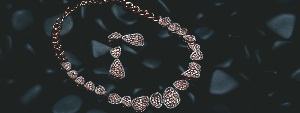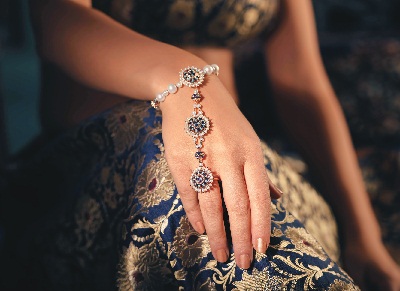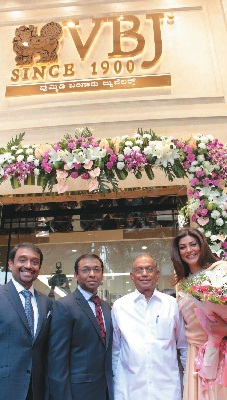Leading South Indian Retailers

From family jewellers who have retained their meritocracy and reputation amidst customers with just a handful of stores to small-town jewellers who have expanded their business not just in India but also abroad, South Indian jewellers are known for their steadfast approach when it comes to business. Legacy, quality and humility define their existence even after being in the trade for several decades. Vijetha Rangabashyam profiles South India’s leading retailers, who have been responsible in shaping the markets regionally, nationally and even internationally.
No region loves gold as much as the South. And when it comes to diamonds, industry experts say that people from the South prefer nothing less than ‘flawless’ in clarity. Some have been jewellers to the royal families while others have started off with all of one store catering to a select few clientele, with no background in jewellery whatsoever. But the common denominators that make all of these brands successful are quality that is second to none and an unwavering trust that their customers have in them.
If legacy and heritage sets apart a few South Indian brands, hope and burning ambition sums up a relatively newer brand like Malabar Gold & Diamonds. Hailing from a humble family of farmers, MP Ahammed began his journey with an icemaking factory in Kozhikode. When the business didn’t reap profits, he ventured into spices. 12 years later, in 1993, he along with a few enterprising entrepreneurs opened Malabar Gold, a jewellery showroom in Kozhikode on a capital of Rs. 50 Lakh. At a time when lack of transparency was rampant in the jewellery industry, Malabar was one of the first brands to introduce 100 % BIS hallmarked jewellery. ‘In Malabar we have always believed in utmost honesty and transparency by paying required tax to the government. Our customers show their faith and loyalty without any reservation. That is our prime USP. We provide our customers quality product at the right price and we give BIS quality, buy back guarantee and insurance,’ says Ahammed MP, Chairman.
The company today has a turnover of USD 4.5 billion and has its presence in over 9 countries. It has about 9 business units with 12,000 employees. We have more than 1700 investors today. In the next three years, we plan to increase the number of showrooms to 500,’ adds Ahammed.
In the year beginning, the brand, which happens to be one among the top 5 jewellery retailers in the world made history by announcing that it is opening 11 Showrooms in 6 countries in a day. Currently, Malabar Gold has 197 showrooms of which 90 showrooms are in India and remaining 107 showrooms abroad. The rapid expansion of showrooms across geographies is part of the Group’s strategy to fast expand its global footprint. In 2017 alone, Malabar Group opened 27 showrooms across nations. What makes the brand stand apart from the rest is also its focus on design. ‘We always upgrade our products with new designs and models. We started with collections like Era, Ethnix, Precia, Mine, Devine and Starlet and we have a lot of choice in light weight jewellery to attract youngsters. Like any other industry, invention and modernization will only help us in being in tune with changing customers. We bring renewed designs to the table and offer choice to our customers, ’ adds Ahammed.
It has been a rollercoaster ride for the jewellery industry and jewellers have been subject to a lot of policy changes over the last couple of years. However, Malabar remains strong and withstands such policy upheavals. In January last year, the company announced a major investment amounting Dh 335 million (US$91.28 million) in expansion plans of its retail network. The move happened at a time when jewellers across the board were struggling to manage their operations. ‘Demonetization and GST, we believe are the main benchmarks in the present financial policy of the government. We support and feel that the government should be more active in bringing all business in jewellery sector under GST. Import should be controlled with small percentage of import duty thereby reducing smuggling,’ strongly opines Ahammed.
Malabar is also one of the few brands hailing from Kerala that has gone from being a single shop to becoming an empire not just in India but abroad as well. Answering what sets apart a quintessential Keralite brand from the rest in the country, Ahammed says, ‘India’s jewellery is very much in demand world over. As a gift article, jewellery takes prime position and gifting occasions are plenty in our country and especially among Keralites. People from Kerala are spread across the world and they all our brand ambassadors.’
One of the cornerstones of Malabar’s business approach is to hire the right person for the right job. ‘All employees are our business partners and they take appropriate decisions with high degree of attention. The top management is free of stress to a certain extent because of this. Our job is to use the right person for the right job, quality will follow automatically,’ signs off Ahammed.

Jithendra Vummidi, MD, VBJ
With a flagship store at the heart of Chennai that makes for a heritage property by itself, VBJ has been serving the jewellery needs of Chennai’s very tasteful audience for several years now. From its humble beginnings in the year 1900 to being the market leader today, the brand has grown from strength to strength by truly standing the test of time. From starting off as a small jeweller to moving on to making gold ornaments that adorned the deities, Sri Vummidi Bangaru soon laid the foundation for a brand that would become a name to reckon with in the jewellery industry. ‘Quality, Design and Service are the tenets on which the brand started, and we follow that religiously even to this day,’ says Jithendra Vummidi, Managing Director, VBJ.
The first proper showroom was opened at Devaraja Mudali Street in Parrys, which continues to be a market place in Chennai even today. This was followed with the setting up of a showroom in Panagal Park, T Nagar. ‘We believe our grandfather as a trendsetter of sorts, being among the first jewellers to set shop at T Nagar and having the foresight that T Nagar would grow to become on the most popular shopping destinations in th country,’ adds Jithendra.
In 1981, Jithendra’s father Sri Raghunath Vummidi branched out from Vummidi Bangaru Chetty, and started Vummidi Bangaru Jewellers.
Jithendra and his brother Amarendra Vummidi are both trained gemologists from Belgium, and manage the family business. In its 118-year old legacy, the brand has won the trust of many loyalists. ‘It has been more than just a family business for us, it has been a way of life and jewellery making runs in our blood. As a brand, we have always focused in never compromising on the quality of our products. VBJ has endeavoured to win the trust of every single customer; this is how we have rated our success over the years. Jewellery customization is our forte – we ensure that the customers’ needs are met and made to perfection.’ The brand even has an in-house creative center where all their original designs and collections are conceptualized and produced. In many cases, they work closely with the clients to put together designs and ideas, to match and enhance the attire by creating bespoke jewellery for an occasion.
VBJ has been growing at a steady and consistent pace over the last few decades and it has systemically increased its customer base whilst retaining our existing customer loyalties as well. The brand expanded its presence by opening a showroom in Jaya Nagar, Bangalore in 2016.

Anand Ramanujam, Director, NAC Jewellers
NAC’s journey started almost 100 years ago in 1917 as a small home-run jewellery business by Nathella Narayana Chetty. He used to handcraft jewels for a handful of loyal customers. But the sweet smell of success took shape only after the opening of a small store by his son Nathella Anantham Chetty in Parry’s Corner in old Madras (now Chennai) in 1927. It was his son N. Anjaneyulu Chetty (Chairman) who coined the name NAC jewellers in 1973, until which time the brand was operating under several names. Along with the able support of his son Anantha Padmanabhan (Managing Director), he was able to transform a mom-andpop business into a chain of jewellery stores. Today, Anand Ramanujam, Director, a fifth generation entrepreneur, runs this legacy, which has been meticulously created by his forefathers. ‘Last year was our 100th year into the business,’ says Anand Ramanujam with a heart brimming with pride. ‘People often think that we’ve been in the industry only since the 70’s but we’ve been around way more than that,’ he adds.
Anand says, down South, jewellery has a special appeal amidst women. ‘They treat jewellery as an essential, rather than a luxury. They need to have a few pieces of gold jewellery on them to show that they are in a good social standing. Also in the South, jewellery is a way of boasting one’s own wealth and one of the reasons why people keep coming back to us because of the customer experience and the kind of designs we offer them,’ adds Anand. According to Anand, a few years ago, legacy and loyalty went hand in hand but today there is ample competition in the market and a brand has to give its clients the complete package. ‘From designs, quality to customer experience, service and packaging, just everything needs to be right,’ adds Anand. What differentiates the South Indian market from the North according to Anand? ‘The South market is extremely price competitive whereas in the North, they don’t mind the price but they want good designs. In the South, in certain segments, they really don’t care about the designs but they want the cheapest.’
NAC opened a larger store in one of Chennai’s prime localities in Mylapore in 1990. 17 years later, a 10,000 sq-ft showroom was opened in the same neighbourhood followed by the inauguration of a flagship store in T. Nagar in 2013. ‘The significant milestone for our brand would be the opening of 3 showrooms in one single day in 2015 and in the same year, one of our jewellery was worn at the Oscars red carpet,’ pipes in Anand.
Though a legacy brand, NAC has always been ahead of the curve when it comes evolving itself as a brand to be in sync with the customers. ‘We’ve always wanted to adapt ourselves to the customers’ change in tastes and preferences, which is why in 2014, we completely revamped our logo. We keep bringing in new designs that are currently popular with the people.’ In 2015, NAC launched Stylori, a one-stop-shop for online buyers.

The online sector was booming and we wanted to be a part of this. We wanted to compete with the likes of Caratlane and Bluestone; actually I think we were the third or the fourth to come into the online space.’ Stylori was created to target audience outside Tamil Nadu. ‘We being a Chennai brand, are known for our quality when it comes to diamonds. People often have the misconception that jewellery sold online has lower quality diamonds and we wanted to break that and offer designs that appeal to the North Indian market as well. The response has been steady and is growing but the online market I feel is still at a very nascent stage. People are still not comfortable buying jewellery online. But this will change in the next few years.’
Speaking of consumer preferences, Anand strongly believes that the charm of loyalty and legacy is slowly dissipating. ‘People don’t want to stick to one brand anymore. They want to try different options before they finalize on one product. This is a reason enough for brands to keep constantly innovating – they need to come up with new designs continuously to keep their customer base intact.’ The experience of buying a product is definitely changing and customers are looking for something different all the time. ‘There are brands that don’t offer the experience and compensate with competitive pricing but that is going to slowly change, if they want to survive in the market for a longer run customer experience is key and we as a brand definitely believe in giving that to our customers.’
Remaining resilient during turbulent times is what makes a brand a brand in Anand’s words, ‘There will always be ups and downs but you have got to face the downs because that is where you can show the stability and the strength of your brand.

Dushyanth Ganjam, Head of Retail, Ganjam
Royalty and Heritage have been closely associated with Ganjam, a 200 year old brand that has its roots in Orissa. With its jewellery, Ganjam has found connoisseurs amidst several Maharajas and Maharanis of yesteryears like the Wodeyars, the royal family of Mysore to the royal family of Nepal. It continues to build on its legacy by catering to the men and women of nouveau India. The legacy of Ganjam dates back to 1889 with a young man called Ganjam Nagappa who having been born into a family of gem trading and jewellery, decided to spread his family’s legacy across India. Ganjam then moved to Hampi, which was then, the capital of Vijayanagara Empire. Over an epoch of time, the business and family moved to Mysore when the city was proclaimed as capital of the Karnataka state. ‘Bangalore has been our base since 1889. Initial practice of trading used to happen from our house and somewhere in 1910 we opened a small store cum office,’ says Dushyanth Ganjam, a 7th generation entrepreneur of the illustrious Ganjam family. ‘In 1971 we opened our first full-fledged retail store in Bangalore. We introduced the new-cut of diamond jewellery, which we called as the ‘Ganjam’ cut in the 1970s.’ 20 years later, in 1990, the store moved into a more cosmopolitan area of Bangalore city.
benchmark in the quality of diamonds in India. ‘We are probably one of the first jewellers to embark on the practice of standardizing quality of diamonds in India. All our jewellery uses a minimum ‘f ’ coloured diamonds,’ adds Dushyanth. Ethnicity has played a major role in Indian jewellery and modernization of Indian designs in the North probably happened somewhere in 70’s and it wouldn’t be an exaggeration to say that Ganjam was responsible in contemporizing ethnic jewellery in the South. From the designs that the brand has created to its collaborations and craftsmanship one thing that sets Ganjam apart is its thirst to be original always.
Patrons have been visiting Ganjam to buy jewellery for generations. The loyalty towards the brand has remained so strong over the years. ‘One very critical aspect has been trust. The effort to maintain consistency in our quality has helped us retain
our consumers’ trust. We deliver what we promise,’ says Dushyanth. The uncompromised quality has made the younger generation also walk into the store with reference photographs of a piece of jewellery that belonged to their ancestors. ‘In India, jewellery has always been viewed as an investment and for that quality becomes of utmost importance. We were able to build on that,’ says Dushyanth. Eswar Ganjam, the Chairman of the company is a living legend who has managed to forge a relationship with almost 4 generations of families when it comes to clients. ‘At some subconscious level, our clients feel safe when they see him. He personally administers the quality of every piece especially with our heritage collection and is in office all 6 days even today,’ quips Dushyanth. Eswar Ganjam was also one of the very few jewellers who believed in preserving the heritage of South Indian jewellery and its craftsmanship at a time when heritage pieces were being melted or sold off. Ganjam is also one of the first brands to introduce the concept of experiential retailing in its stores. It opened its flagship store in 2015 in Vittal Mallya road, Bangalore. Spread over 10,000 sqft, is a contemporary interpretation of a temple that reflects the deep heritage of Ganjam. The space is evocative of Hampi and Dravidian architecture and the store has been created keeping in mind the guidelines that govern Vastu to ensure that energies have been utilized to achieve greater harmony with nature.

Along with the store, an art gallery was also inaugurated featuring photographs by the legendary fashion and fineart Indian photographer Prabuddha Dasgupta. ‘We were the first jewellers to launch a store in a boutique format and retail was seen without a border. Generally when you go to a shop there is always a line between the sales person and a customer. In our Leela boutique in Bangalore, there is no such barricade between customers and salesmen. That became a very important aspect for our brand because customers could move around and see the jewellery in 360 degree,’ he adds.
Ganjam has seen the potential design has over all other aspects early on and it is one brand that is constantly reinventing itself to be in tune with the evolving tastes of the consumers. ‘Earlier jewellery was bought for security and as an investment. Now, people are buying jewellery purely for its design and style. They pick pieces that enhance their personality. For the affluent class, investment and security are not very important, they believe in being relevant and that is where design plays a strong role. Also earlier, their family’s opinion mattered the most, now consumers want to make a statement to their peers, like friends,’ he adds.
A philosophy Ganjam has always believed in is ‘to retain the core intact’ and this has helped the brand fight through turbulent times that the industry has thrown at it. ‘Our core is built on quality, trust and heritage. We’ve never given up on these and so during tough times we’ve been able to be strong. The stronger the anchor is, the more the ship can weather. We also believe in making a few strategic changes in the way we function to make sure that such turbulences don’t impact us gravely. If we sacrifice the core, we become a very shallow brand,’ adds Dushyanth.
Though Ganjam has its roots in the South, it is hardly a South Indian brand anymore. However, Dushyanth feels that the North and South Indian markets are very different. “Perception of quality is very different in these two regions and also trends are not short sighted like it is in the North. Buying into trends and styles are slower in the South but they sustain longer. In the South, consumer’s perception of preciousness of jewellery is much higher. So the concept of hand-medowns is stronger. Ganjam has fitted very will within the North Indian narrative as well, because our pieces are both classic and contemporary,’ Dushyanth concludes.
Hailing from the port city of Vishakapatnam, Vaibhav Jewellers is yet another stellar example of a small-town brand that spread its wings across Andhra Pradesh, Telangana, and Orissa as well. ‘Vaibhav jewellers came to Vishakapatnam in the year 1994-95 to create a household brand for Vizagities by late Manoj Kumar Grandhi who hails from Eluru. We started our journey by selling jewellery through personal marketing which gave us the confidence to set up a 1000 sq ft store in the year 1995 and from then on our journey moved leaps and bounds to 30000 sqft mall in city during the year 2007-08 which was one of the largest in those times,’ says R. Satish, CEO, Vaibhav Jewellers. At a point of time when people used to largely depend on small time smiths, Manoj Kumar Grandhi established a multi floor jewellery retail outlet which was a “never before concept” in Vizag.
Vaibhav also came into the market at a time when competition was already stiff, with market share already being consumed by big retailers. ‘Throughout the journey our prime focus has been on customer delight. We have achieved this by distinguishing designs, by building the trust factor and customer satisfaction. We always believed in the philosophy that one satisfied customer will bring in more customers to our showroom which is an old saying but we religiously followed it. In jewellery industry trust is paramount and over the years we as a brand have earned that and we were the pioneers in this space and most of the competitors followed us,’ says Satish.
Apart from establishing a 30000 sqft showroom in the city of Visakhapatnam in the year 2007-08, the brand expanded to other parts of coastal Andhra from the year 2013-14 onwards. Recently, during this financial year Vaibhav opened 2 more stores in Hyderabad, which was a big stepping stone and also gave the brand a big pull in the south market. Most of the times, customers are drawn towards a brand when they can relate to it, by way of its uniqueness, presence , customer centricity, reach and most of all the feel of being a local brand which is easily approachable has made the brand a household name. Vaibhav credits its success to paying heed to consumer preferences, every step of the way. ‘Consumer preferences for gold has not changed, what has changed is the rationale behind buying gold. Casual purchases, occasion based purchases, discount/offer based purchases and gifting of gold has risen over the years. Secondly, customers are drawn towards customized jewellery. Also customers nowadays are more informed which also helps us to be prepared for each season and accordingly work towards satisfying them by all means.’
Vaibhav Jewellers believes in complete compliance and even though the implementation of demonetization and GST brought in some amount of uncertainty, things evened out gradually. ‘They come with their own merits and demerits, because of which there is a slight market correction. As IMF rightly put it “GST & Demonetization will bring long term benefits”. As an organization initially we had problems especially GST as it was not clear and there were so many amendments. Now, as an organization, we want GST which will have long term benefits.’
What differentiates the South Indian market from the North is their adulation of pure gold. ‘North is more of stones based jewellery, either natural stones or diamonds. Now the trend is slowly changing. South is moving towards stones as well which is a good sigh,’ concludes Satish.
Be the first to comment